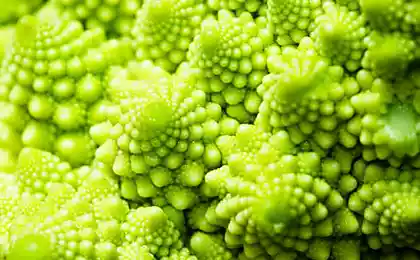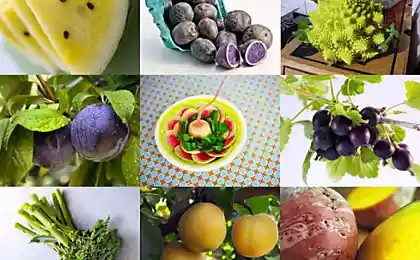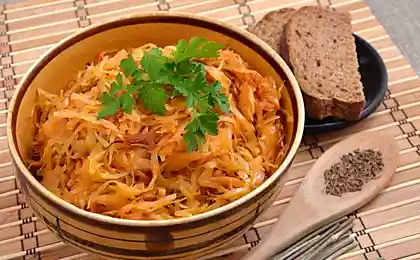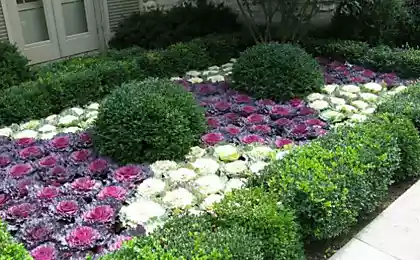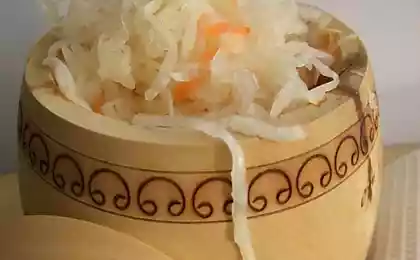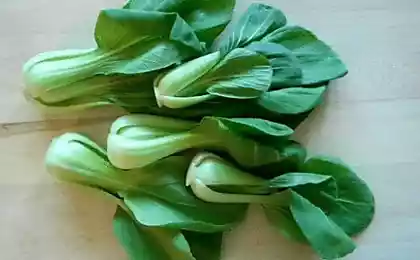1234
Romanesco cabbage - very beautiful natural FRACTAL

Fractal - a geometrical figure, some of which are repeated over and over again, varying in size. This is the principle of self-similarity. Fractals are like ourselves, they are similar to themselves at all levels (ie, at any scale). By and large, the world around us, there are many different types of fractals. One could even argue that everything that exists in the real world, is a fractal, whether the cloud, a molecule of oxygen, wood, beach, human blood vessels. All these structures are self-similar.
For example, from the branches, as well as from a tree trunk, shoots depart less from them - even smaller, and so on. E., That is similar to the entire tree branch. Similarly arranged and circulatory system: arteries are moving away from the arterioles, and from them - the smallest capillaries in which oxygen enters the tissues and organs. Similarly, the coastline when zoomed remains similar to itself. This property is called the fractal objects, scientists, and the objects themselves - fractals (from the Latin fractus - broken, crushed, broken).
Those skilled in the field of computer technology, for example, it is well known that fractals infinite complexity and beauty can be generated by simple formulas. The film industry to create a realistic landscape elements (clouds, rocks and shadows) commonly uses fractal graphics. There is a feeling that wise Nature, creating objects and systems on fractal principle, as it gives people a chance to better understand and explore herself. For example, studying the fractal system, scientists are trying to predict the patterns that, at first glance, seem to be completely unpredictable and chaotic.

Back to our cabbage romanesco. It is also called coral or cabbage Romanesque broccoli. Many believe that this hybrid cauliflower and broccoli was created only recently, almost none in the 90s of the 20th century, the Roman breeders and designers 3D graphics and that they allegedly gave her a fanciful and beautiful form in which the inflorescence cabbage romanesco located at logarithmic spiral.
Hard to believe, because breeders could really cross with broccoli cauliflower, but the rest, I think, took care of her majesty of Nature. As for pollination mentioned two kinds of cabbage, it could happen in a natural way. There is also a version that Romanesco cabbage was known to people already in the 16th century.
Cabbage romanesco, Latin Brassica oleracea, is an annual plant, which is a subspecies of the cauliflower. If you carefully scrutinize each inflorescence or bud romanesco, it will clearly see that each successive bud consists of a set of the same in the structure of buds, but much smaller. Cabbage romanesco, may not have such a popular product, like its cousin cauliflower and broccoli.

However, the beneficial properties of cabbage romanesco and distinctive delicate taste of the product is gradually deserve worldwide recognition and popularity. Calorie Cabbage romanesco is an incredibly low and comparable to that of cucumber. In addition, the chemical composition Romanesco replete vitamins B and C and minerals zinc and carotene. Prepare similarly cabbage romanesco cauliflower and broccoli, which are its closest relatives. For the typical dishes from her excellent deep aroma, nutty creamy and very mild flavor.
Cabbage romanesco, due to its vitamin content, is the perfect beauty products. Low in calories, rich in vitamins, minerals and dietary fiber. All this contributes to the natural cleansing of the body and makes the skin radiant and hair - thick and strong. Impressive and mineral composition of romanesco - iron, phosphorus, calcium, potassium.
Vegetable contains rare minerals - selenium and fluorine, and can be recommended to anyone who wants to preserve the health of the teeth, the integrity of the tooth enamel. Selenium is able to protect our body against cancer, helps absorption of dietary antioxidants. Included in the cartilage is important for healthy joints. Affects the hormonal balance, it contributes to the work of skeletal and smooth muscle. Romanesco, as well as other sources of folic acid is recommended when planning pregnancy and, if properly transferred to the power while carrying a child.
The plant is very sensitive to changes in temperature and humidity, so in extreme circumstances for her she can not tie heads. Cabbage may not form the inflorescence and the wrong timing of sowing.
As practice shows, tying heads occurs from not very high temperature (18 ° C). Therefore, the seeds of cauliflower later varieties to sow in such a way that the formation of inflorescences occurred, for example, in September, when the nights are already cold. Of course, the head will be formed much more slowly, but will grow larger. Cabbage heads of cabbage can not engage if not followed the correct temperature, soil moisture for growing seedlings.
Seeds are sown in boxes for 45-60 days prior to transplanting in the open ground. Until germination the room temperature recommended maintained within 20-22 ° C, and then it must be reduced to 8-10 ° C during the day and 6-8 ° C at night. At the same time, the seedlings of cabbage is in need of a good light and moderate watering. If done correctly, the seedlings will be strong, stocky, with a strong root system, moreover, it will have good resistance to adverse conditions.
We should not forget that the cabbage is very moisture-loving. Drought during the formation of rosettes of leaves and cabbage head negatively affect the harvest, so the cabbage should be watered regularly. Too late or too abundant feeding may badly affect the formation of inflorescences, which may not be fastened at all. Instead of head, you risk getting a huge bouquet of cabbage leaves.
The first feeding is recommended after a week and a half or after transplanting into the ground infusion of mullein (10 liters of water of 0, 5 liters of liquid mullein and 1 tbsp. Spoon full of mineral fertilizers). A second feeding is carried out in two weeks after the first working solution consisting of 30 g of ammonium nitrate, 2 g of potassium chloride, 40 g of superphosphate and 2 g of boric acid in 10 liters of water. The third feeding - when the sprouts begin to form buds. For this mullein diluted with water (1: 8), and 10 liters of solution was added to 30 g of superphosphate and ammonium nitrate and 20 g of potassium chloride.




